Movement part 1
1/35
There's no tags or description
Looks like no tags are added yet.
Name | Mastery | Learn | Test | Matching | Spaced |
|---|
No study sessions yet.
36 Terms
role of posture in occupational engagement
1. Control the body’s orientation in space
2. Maintain the body’s center of gravity over its base of support
3. Stabilize the head with respect to the vertical plane to maintain a good eye gaze in the environment
4. Good posture facilitates safe and biomechanically sound engagement in occupations
Normal posture:
▹ Head is well balanced minimizing stress on the cervical musculature.
▹ Normal curves of the spine
▸ Concave (cervical spine)
▸ Convex (thoracic spine)
▸ Concave (lumbar spine)
▹ Neutral Pelvis:
Provides good alignment for the abdominals, trunk and LEs
▹ LEs positioned ideally for weightbearing
▹ Optimal function for respiratory organs in this position
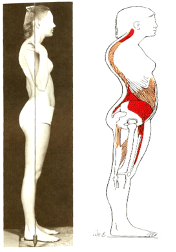
Kyphotic-Lordotic Posture:
Head: Forward
Cervical Spine: Hyperextended
Scapulae: Abducted
Thoracic Spine: Increased Kyphosis flexion
Lumbar Spine: Increased Lordosis Extension
Pelvis: Anterior Tilt
Hip Joints: Flexed
Knee Joints: Slightly Hyperextended
Ankle Joints: Slightly Plantar flexed
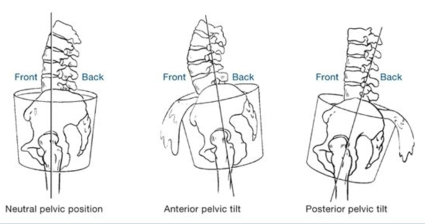
▸ Anterior pelvic tilt
- The forward movement of the pelvis
- Produced when the ASIS moves in an anterior and inferior direction.

Sway-back posture-1:
Head: Forward
Cervical Spine: Slightly Extended
Thoracic Spine: Long Kyphosis flexion
Lumbar Spine: Flat
Pelvis: Posterior Tilt
Knee Joints: Hyperextended
Ankle Joints: Neutral
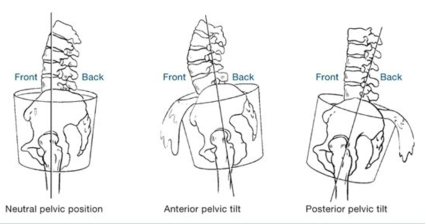
▸ Posterior pelvic tilt
- Pelvis is closer to the posterior aspect of the femur as the pelvis rotates backwards
- PSIS moves posteriorly and inferiorly
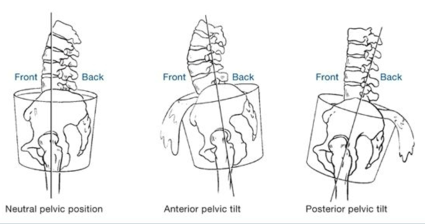
▸ Lateral pelvic tilt
- one side of your pelvis is tilted to your left or right, causing one side of your hip to appear higher than the opposite side.
• how to conduct a postural examination.
Line of gravity passes through:
1. Mastoid process of the jaw/earlobe
2. Continues to a point just in front of the shoulder
3. Continues through greater trochanter of femur
4. Continues to a point posterior to patella
5. Continues anterior to lateral malleolus
Can use a plumb line to check alignment
Determines if the points of reference are in the same alignment as the corresponding points in ideal
posture
Deviations reveal the extent to which the alignment is faulty
▪ Slight
▪ Moderate
▪ Marked

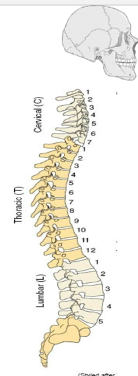
spine
aka spinal column, vertebral column
▹ Series of counterbalancing anterior-posterior curves
▹ Curves provide spine with more strength and resilience
▹ Direction of curve depends on vantage point
7 Cervical vertebrae – convex anteriorly
12 Thoracic vertebrae – convex posteriorly
5 Lumbar vertebrae – convex anteriorly
5 fused sacral vertebrae – convex posteriorly

Pelvis:
Important to posture
- anterior superior iliac spine
- posterior superior iliac spine
- iliac crests
- sacrum
- ischial tuberosities: sit bones

▹ Base of support –
Area under the mass (we can usually think of it as the area under the persons body), which supports the mass or person from falling. How do we widen our base of support?

▹ Center of mass/gravity –
Point about which all the body mass is balanced, usually a point in the trunk of body.
▸ If someone is bent over due to their condition or injury the center of mass will not be in the usual position, but will be forward relative to their base of support.
Balance is considered to be maintained when the center of mass is over the base of support.

Center of gravity (COG):
Focal point at which gravity acts and around which the weight of an object is evenly distributed
Lower COG increases stability
As weight distribution changes, the COG migrates in proportion to direction and magnitude of movement
The exact location depends upon the individual’s body size and the distribution of muscle and bone that have different densities.
Base of support (BOS) in Standing:
area including the two feet and the space between the feet. How about when we add a walker?
▹ Maintenance of standing balance following small changes or perturbations is thought to be controlled primarily by the muscles around the ankle. (Postural sway)
▹ Larger perturbations require muscles at the hip joint to return a person to the upright position.
▹ Very large perturbations require a person to take a step in order to prevent loss of balance.
▹ BOS in Sitting:
area in contact with the seating surface.
Static Balance –
Balance occurs when a person is not moving, or moving with limited movement outside of base of support
▹ Dynamic Balance –
This is balance while movement occurs. A person can be considered to have this balance while moving by staying upright.
Ways to increase balance
▹ Visual Anchors – The person focuses on a specific point after movement, to enhance balance control.
▹ Widen base of support with device
▹ Improve posture
▹ Improve vision
▹ Improve sensation/proprioception
▹ Address environment
▹ Information from the ankle, spine, neck muscles, tendons and joints are used for two tasks:
▸ Balance control
▸ Orientation of the body in space
▸ Integration of these two tasks (balance control and orientation of the body in space)
▹ Vestibular input from inner ear canals provides sensation for balance (Problems would include vertigo, dizziness, nausea, spinning and whirling)
▹ If sensory input is impaired, such as after a stroke or traumatic brain injury, balance may be impaired even if the person has good muscle function.
How do OTs assess balance?
▹ Observation of functional tasks
▹ Up in environment or even seated at EOB
▸ How would we assess static and dynamic balance seated at EOB?
- Sitting
- Object on floor
- Reaching
- Postural challenge
- Can also do standardized tests
Quick tests to assess balance
Functional Reach Test
- Timed Up and Go
- Longer Test:
Berg Balance Scale
▹ PT often does the longer assessments as part of their gait/assistive device assessment.
gait
the style of walking
we look at the following characteristics to analyze gait:
• symmetry
• arm swing
• body position (should be upright, not stooped forward)
• stride length
• heel-on, toe-off (your heel touches the floor first. Then your toe pushes you off)
• stability while turning
Cadence
average step rate per minute
• Step Length:
distance between placement of right and left foot (R Heel to L Heel)
• Stride length:
distance between two placements of same foot R Heel/ R Heel
• Walking base:
distance between line of two feet, it is usually wider with balance deficits
• Gait training:
done by PT to improve walking and improve abnormal gait patterns, recommendation for bracing and ambulation aids
• Ambulation aids:
crutches, canes, walkers and braces
Functional ambulation:
How a person walks while achieving a goal
STANCE PHASE:
body support on each leg alternately
SWING PHASE:
Advancement of swinging leg to allow it to then support the body
Normal walking pattern:
STANCE PHASE: body support on each leg alternately
SWING PHASE: Advancement of swinging leg to allow it to then support the body
Balance
Power to move LEs and trunk